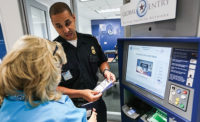Facial recognition companies are seeing opportunity in their services with the Coronavirus in identifying individuals without the risk of close contact, according to OneZero.
DERMALOG, a biometrics company that makes fingerprint, iris, and facial recognition hardware, has adapted its technology to determine temperature and is pitching the update as a safety feature, says the news report. Telpo is launching temperature-sensing terminals with facial recognition, which allegedly work even if a person is wearing a face mask.
“In the face of this outbreak, we have developed a solution for noncontact body temperature measurement plus face recognition in order to meet the rapid need to diagnose the patient and isolate and control the virus in time,” Crystal Chu, a platform marketing specialist at Telpo, wrote to OneZero in an email.
In a press release, Telpo says it's solution can detect body temperature within 0.7 meters to reduce close contact, and realize 24-hour temperature measurement. When abnormal body temperature is found, a real-time voice warning is started, which will help the company quickly measure and select employees with abnormal body temperature.
Steve Durbin, managing director of the Information Security Forum, a London-based authority on cyber, information security and risk management, tells Security Magazine that, “There is, of course, a space for facial recognition systems and their potential use, especially during the COVID-19 pandemic, is clear in becoming an alternative to fingerprint and other biometric technologies that rely on touch based sensors."
However, notes Durbin, there are many privacy concerns. "The issue of privacy and protection of the rights of the individual remains unchanged. Facial recognition is not a perfect science, we have seen public dissatisfaction with the way in which some governments have used facial recognition resulting in its withdrawal from use. For facial recognition systems to become an acceptable, widely used means of validating that we are who we say we are we first need to ensure that the privacy rights of the individual are protected, that the data is responsibly collected, stored and managed and that its use is restricted to the purpose for which it was originally taken. I think we are a long way off these safeguards being consistently rolled out.”
Matt Gayford, Principal Consultant at the Crypsis Group, a McLean, Va.-based incident response, risk management and digital forensics firm, also tells Security Magazine that, “While facial recognition technology provides a fast and zero-contact method for identifying individuals, the technology is not without risks. Primarily, individuals scanned by facial recognition services need to be aware of how their data is being used."
Faced with a pandemic, adds Gayford, the public may be rapidly accepting the risks involved with providing biometric data for healthcare services, but individuals should not be so quick to give up that data. "It’s important to understand the legal implications and potential repercussions to an individual’s privacy. Before using the services, individuals should understand how their data will be used, where it will be stored, and who will have access to it. If used by third parties, it would be possible to identify individuals on security cameras using the facial recognition data. Advertisers could easily build a profile of shopping behaviors and begin targeted advertising. On the other end of the spectrum, the same data could be used to track an individual’s movements, habits, and even their online presence by scraping photos from social media."
In the United States, cities and states have passed legislation to regulate the use of biometric and facial recognition data, says Gayford. "However, many of these locations have different ideas about what is acceptable and what should be prevented. The House Oversight Committee has been planning a hearing to discuss the use of facial recognition technology but has already experienced delays and stated that legislation won’t happen any time soon. In such an emerging market, it’s critical for consumers to stay informed and to read the fine print, even in the face of crisis.”
Rui Lopes, Engineering and Technical Support Director at Panda Security, a provider of IT security solutions, adds that, “One of the unforeseen outcomes of the novel coronavirus pandemic is the rise of advanced facial recognition devices in lieu of traditional fingerprint scanners for various points of entry, such as in buildings, at airports, and even at quarantine checkpoints in areas of lockdown. Facial recognition, in connection with body-temperature technology, has proven to be very helpful in various countries, helping to prevent the spread of COVID-19 and to identify those who may be sick."
In China, for instance, facial recognition is being used to determine if people are following local regulations and restrictions, according to OneZero. In Russia, as well, the technology is being used to detect those who are leaving their homes amid quarantine restrictions.
Lopes adds that, "Facial recognition has its drawbacks: personal protective equipment such as masks render it useless, and numerous privacy issues come with the technology. For example, using facial recognition, it is easier than ever for governments to monitor and track their citizens, destroying the assumed privacy that comes with anonymity in a crowd. Great care must be taken by any organization that adopts facial recognition at this time, and should disclose their data collecting practices. It is easy to imagine hackers going after a database of facial recognition data to exploit, thereby giving criminals yet another weapon to use.”



